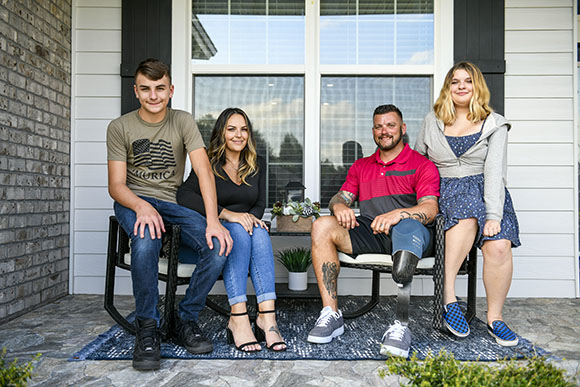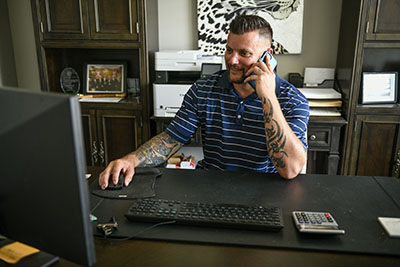Warrior Manages PTSD and Overcomes Invisible Wounds of War

June is PTSD Awareness Month
Sean Karpf is a husband, father, brother, son, business owner, and loving friend. He is also a veteran who manages post-traumatic stress disorder (PTSD).
Giving voice to the drive and purpose of men and women who sacrifice to serve our country and bravely reinvent themselves in the civilian world is a theme in Sean’s life. Sean has come through visible and invisible injuries to blaze new trails for other injured veterans.
At a young age, Sean’s life plan was a career in the Army.
“I was with the 82nd Airborne out of Fort Bragg, North Carolina,” Sean said. “When I was injured in June of 2012, I was a sergeant, a weapons squad leader.”
Sean signed with the Army because he admired his uncle, who served in the 101st Airborne Division. Sean felt fulfilled as a soldier and reenlisted the month before he was injured in Kandahar, Afghanistan. He trusted his Army unit and they trusted and protected him.
“You knew there were people around you who cared for you and loved you just as much as you did them,” Sean said about his Army unit.
Sean was on a dismounted patrol and responding to a call to move to the front with his unit when he stepped on the pressure plate of an improvised explosive device (IED). He heard others yell his name, and then it was just the ringing in his ears and a cloud of dust.
Before the dust settled, Sean started to pull himself out of the crater left by the explosion. He worried a second explosion could cause further injury or hurt any fellow soldiers who were rushing to help. Sean was conscious as he was carried on a stretcher with only a tourniquet on his left leg and bones poking out of his foot and lower leg. He remembers steadying the pieces of his injured left leg with his right leg as they bumped along the path to safety. There was enemy fire aimed at the medevac helicopter as it attempted to land. After a gunfight, the helicopter picked up Sean on the second attempt.
There was another injured soldier already in the helicopter. Sean couldn’t see what was happening on the ground but could hear his unit still fighting.
Watch veteran Sean Karpf explain his experience coping with PTSD.
“My injuries, the ones you can see, are the amputation of my left leg below the knee and my traumatic brain injury,” Sean said. “The worst injury was PTSD, because now I can put on my leg and I can take it off, but I can't control the way I feel. I'm not the same person I was before, and that's one of the hardest things that people don't understand. A lot of people think PTSD is just, ‘Oh, they go crazy. They hear a loud noise, they freak out,’ but it's deeper than that.”
When Invisible Wounds are More Challenging Than Visible Ones
According to WWP’s Annual Warrior Survey, almost 20% of warriors served by WWP reported difficulty or delays in receiving or continuing mental health care after separating from the military.
“Year over year, we see that mental health challenges top the list of current issues being faced by the warriors we serve at Wounded Warrior Project,” said Melanie Mousseau, vice president of program operations and partnerships at WWP. “In fact, we see that mental health issues are more than twice as common as physical ones among Wounded Warrior Project warriors in the Annual Warrior Survey.”

A week after the attack, and once Sean was at Walter Reed National Military Medical Center, the decision was made to amputate his left leg. It would be 15 months before Sean and his wife could leave the hospital and return to their home in Florida.
When Sean came home to his family, including two young children, it didn’t take long to realize that, beyond the physical, he was not the same as before.
“I used to flip out over nothing,” Sean said. “I remember being very hard on my son at his baseball games, and he was only 7 years old. It wasn’t fair, and it wasn’t really me.”
“My wife sat me down and said, ‘You need to start talking to somebody,’” Sean said.
Wounded Warrior Project® (WWP) was there to help Sean meet other injured veterans and join a career transition program that helped him go back to college to get his degree. In the process, he started overcoming his PTSD. He was interacting with other warriors, sharing stories, and connecting on a one-on-one level.
“I don’t think if I had jumped right into school, without Wounded Warrior Project, that I would have had the right mindset to succeed,” Sean said. “They gave me the tools to be successful.”
The WWP training program led to an internship with the NFL’s Jacksonville Jaguars. He did everything from ticket sales to field assistance. After completing his degree in kinesiology, the Jaguars hired him as a strength and conditioning associate.
Growing and Finding Joy in Helping Others
Through WWP, his college career, and his work with NFL players, Sean gained experience and confidence that he eventually translated into an enterprising idea for a new business. He decided his new pressure washing business would be named “A Leg Up Pressure Washing” – a wink to his own experiences as an injured veteran overcoming physical and mental obstacles.
In addition to starting a business, Sean makes time to give back via WWP events that put him in front of other veterans to motivate and empower them.
“To me, Wounded Warrior Project's always been there, and that is something that we need to have as wounded warriors, to be able to come together,” Sean said. “It’s important to be around people with shared experiences, who have been through the same situations and be able to feel comfortable.
“When I first came back to Jacksonville, I never thought I would go to college in a million years. I started college, stuck with it, and got my master’s degree in sports medicine and went from that to being a full-time member on the Jaguars’ strength and conditioning staff. It's all because of the tools that I learned from Wounded Warrior Project at the beginning.”
Sean said he also did not expect to start his own business one day. “It's those tools that help empower me, and help build me up, and give me the confidence to just jump into it and do it.”
These days, Sean stays in touch with fellow warriors and makes time for his family. Other veterans he met through WWP have encouraged him to build his business and even helped with the design of his logo. He takes his teenage son on jobs and finds balance between making money and making time for family.
If a leg up in a race gives one an advantage in a competition, Sean has figured out that by putting his mental wellness first, he can give himself a leg up on the things that matter most in life. He credits support from his family, friends, and WWP with reaching this new stage of his life.
“Wounded Warrior Project doesn’t just help with one aspect of a warrior’s life; it’s very well-rounded,” Sean said. “It’s not just handing out money. They are a hand up, not a handout.”
Learn more about how WWP helps warriors and caregivers #CombatStigma through mental health programs and PTSD treatment options.
Contact: Raquel Rivas – Public Relations, rrivas@woundedwarriorproject.org, 904.426.9783
About Wounded Warrior Project
Since 2003, Wounded Warrior Project® (WWP) has been meeting the growing needs of warriors, their families, and caregivers — helping them achieve their highest ambition. Learn more.